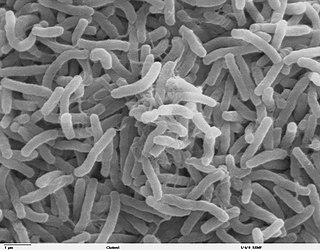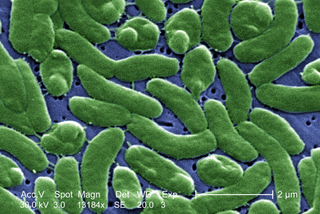Related Research Articles

Cholera is an infection of the small intestine by some strains of the bacterium Vibrio cholerae. Symptoms may range from none, to mild, to severe. The classic symptom is large amounts of watery diarrhea that lasts a few days. Vomiting and muscle cramps may also occur. Diarrhea can be so severe that it leads within hours to severe dehydration and electrolyte imbalance. This may result in sunken eyes, cold skin, decreased skin elasticity, and wrinkling of the hands and feet. Dehydration can cause the skin to turn bluish. Symptoms start two hours to five days after exposure.

Vibrio cholerae is a Gram-negative, comma-shaped bacterium. The bacterium's natural habitat is brackish or saltwater where they attach themselves easily to the chitin-containing shells of crabs, shrimps, and other shellfish. Some strains of V. cholerae cause the disease cholera, which can be derived from the consumption of undercooked or raw marine life species. V. cholerae is a facultative anaerobe and has a flagellum at one cell pole as well as pili. V. cholerae can undergo respiratory and fermentative metabolism. When ingested, V. cholerae can cause diarrhea and vomiting in a host within several hours to 2–3 days of ingestion. V. cholerae was first isolated as the cause of cholera in 1854 by Italian anatomist Filippo Pacini and by the Catalan Joaquim Balcells i Pascual in the same year, but their discovery was not widely known until Robert Koch, working independently 30 years later, publicized the knowledge and the means of fighting the disease.

Vibrio is a genus of Gram-negative bacteria, possessing a curved-rod (comma) shape, several species of which can cause foodborne infection, usually associated with eating undercooked seafood. Typically found in salt water, Vibrio species are facultative anaerobes that test positive for oxidase and do not form spores. All members of the genus are motile and have polar flagella with sheaths. Vibrio species typically possess two chromosomes, which is unusual for bacteria. Each chromosome has a distinct and independent origin of replication, and are conserved together over time in the genus. Recent phylogenies have been constructed based on a suite of genes.

Vibrio vulnificus is a species of Gram-negative, motile, curved rod-shaped (bacillus), pathogenic bacteria of the genus Vibrio. Present in marine environments such as estuaries, brackish ponds, or coastal areas, V. vulnificus is related to V. cholerae, the causative agent of cholera.

Aliivibrio fischeri is a Gram-negative, rod-shaped bacterium found globally in marine environments. A. fischeri has bioluminescent properties, and is found predominantly in symbiosis with various marine animals, such as the Hawaiian bobtail squid. It is heterotrophic, oxidase-positive, and motile by means of a single polar flagella. Free-living A. fischeri cells survive on decaying organic matter. The bacterium is a key research organism for examination of microbial bioluminescence, quorum sensing, and bacterial-animal symbiosis. It is named after Bernhard Fischer, a German microbiologist.

Vibrio harveyi is a Gram-negative, bioluminescent, marine bacterium in the genus Vibrio. V. harveyi is rod-shaped, motile, facultatively anaerobic, halophilic, and competent for both fermentative and respiratory metabolism. It does not grow below 4 °C. V. harveyi can be found free-swimming in tropical marine waters, commensally in the gut microflora of marine animals, and as both a primary and opportunistic pathogen of marine animals, including Gorgonian corals, oysters, prawns, lobsters, the common snook, barramundi, turbot, milkfish, and seahorses. It is responsible for luminous vibriosis, a disease that affects commercially farmed penaeid prawns. Additionally, based on samples taken by ocean-going ships, V. harveyi is thought to be the cause of the milky seas effect, in which, during the night, a uniform blue glow is emitted from the seawater. Some glows can cover nearly 6,000 sq mi (16,000 km2).

The Vibrionaceae are a family of Proteobacteria given their own order, Vibrionales. Inhabitants of fresh or salt water, several species are pathogenic, including the type species Vibrio cholerae, which is the agent responsible for cholera. Most bioluminescent bacteria belong to this family, and are typically found as symbionts of deep-sea animals.

Vibrio parahaemolyticus is a curved, rod-shaped, Gram-negative bacterium found in brackish, saltwater, which, when ingested, causes gastrointestinal illness in humans. V. parahaemolyticus is oxidase positive, facultatively aerobic, and does not form spores. Like other members of the genus Vibrio, this species is motile, with a single, polar flagellum.
Vibrio natriegens is a Gram-negative marine bacterium. It was first isolated from salt marsh mud. It is a salt-loving organism (halophile) requiring about 2% NaCl for growth. It reacts well to the presence of sodium ions which appear to stimulate growth in Vibrio species, to stabilise the cell membrane, and to affect sodium-dependent transport and mobility. Under optimum conditions, and all nutrients provided, the doubling time of V. natriegens can be less than 10 minutes. In the laboratory, the growth medium can be easily changed, thus affecting the growth rate of a culture. V. natriegens is commonly found in estuarine mud.
Vibrio alginolyticus is a Gram-negative marine bacterium. It is medically important since it causes otitis and wound infection. It is also present in the bodies of animals such as pufferfish, where it is responsible for the production of the potent neurotoxin, tetrodotoxin.
Vibriocins are a group of bacteriocins produced by, and active against, gram-negative bacteria in the genus Vibrio. They were first discovered in 1962, considerably after the original bacteriocins, the colicins, which were discovered in 1925.

A bacillus, or bacilliform bacterium, is a rod-shaped bacterium or archaeon. Bacilli are found in many different taxonomic groups of bacteria. However, the name Bacillus, capitalized and italicized, refers to a specific genus of bacteria. The name Bacilli, capitalized but not italicized, can also refer to a less specific taxonomic group of bacteria that includes two orders, one of which contains the genus Bacillus. When the word is formatted with lowercase and not italicized, 'bacillus', it will most likely be referring to shape and not to the genus at all. Bacilliform bacteria are also often simply called rods when the bacteriologic context is clear.
Vibrion may also refer to: the singular form of vibrio, a genus of anaerobic bacteria with a comma-like shape. Vibrion is an antiquated term for microorganisms, especially pathogenic ones; see Germ theory of disease. The term was specifically used in reference to motile microorganisms, and the name of the genus Vibrio derives from this term. The term is closely tied to the history of the study of cholera. It was used in biological literature between the late 19th century and the 1920s.

Bacteria and Archaea are classified by direct examination with the light microscope according to their morphology and arrangement.
ATCvet code QI10Immunologicals for Pisces is a therapeutic subgroup of the Anatomical Therapeutic Chemical Classification System for veterinary medicinal products, a system of alphanumeric codes developed by the World Health Organization (WHO) for the classification of drugs and other medical products for veterinary use. Subgroup QI10 is part of the anatomical group QI Immunologicals.

Aliivibrio is a genus in the phylum Proteobacteria (Bacteria).
Myristyl aldehyde, also known as tetradecanal, is a reduced form of myristic acid.
Vibrio adaptatus is the name given to a Gram-negative species of bacteria first described from the ocean by ZoBell and Upham in 1944. It was later shown to be genetically very different from other species of Vibrio, suggesting it belongs in a different genus, However, it has not been further studied and assigned to a genus, and remains an unclassified bacterial strain within the Alphaproteobacteria, just like Vibrio cyclosites.
Schizotequatrovirus is a genus of viruses in the order Caudovirales, in the family Myoviridae, in the subfamily Tevenvirinae. Bacteria serve as natural hosts. There are currently three species in this genus, including the type species Vibrio virus KVP40.
Vibrio casei is a Gram-negative species of bacterium in the genus Vibrio. Strains of this species were originally isolated from portions of French soft cheese. Genetically similar species and strains have been found in American cheesemaking plants.
References
- ↑ (Thompson et al. 2011 doi: 10.1099/ijs.0.030015-0)
| This Gammaproteobacteria-related article is a stub. You can help Wikipedia by expanding it. |